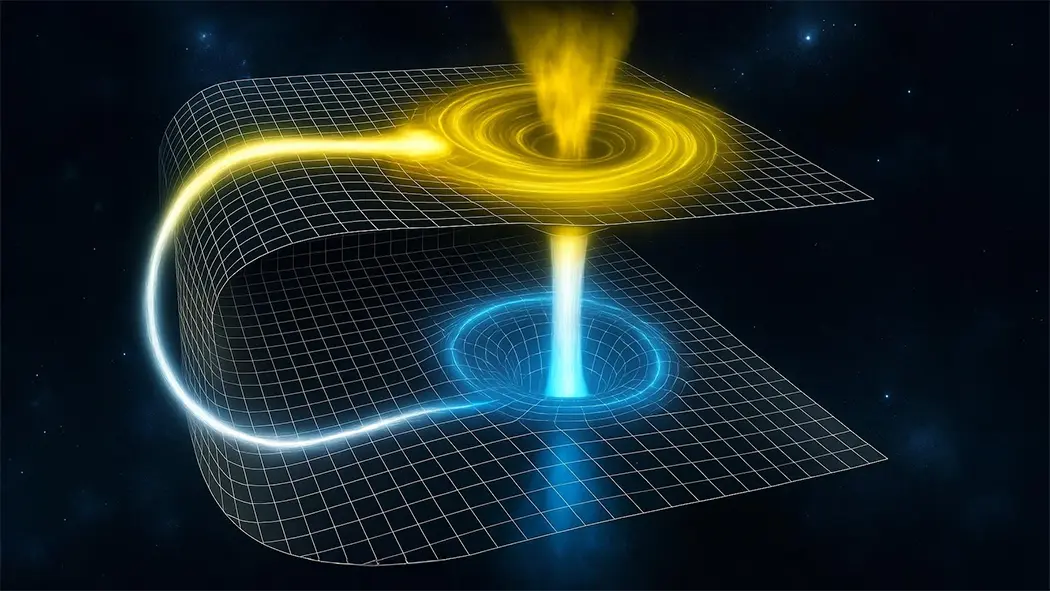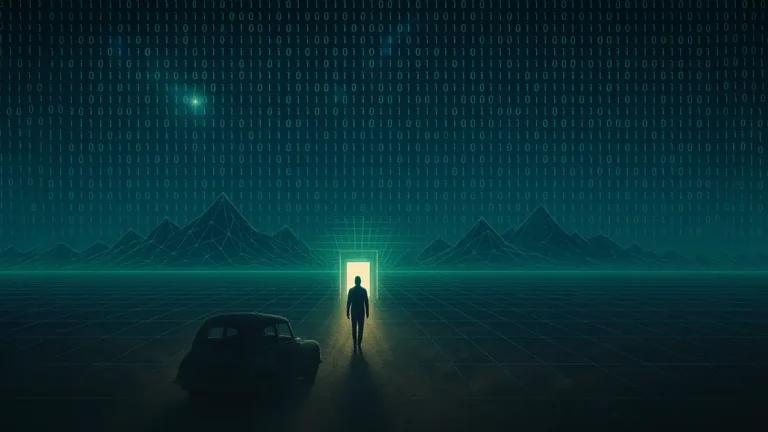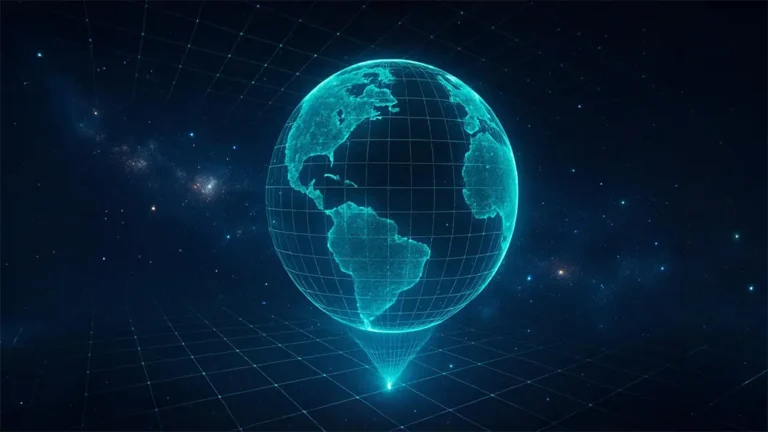Have you ever wondered if we could travel across the universe quickly? What if there’s a shortcut in space? Could it let us jump from one galaxy to another in an instant?
The idea of the Einstein-Rosen bridge is one such shortcut. It comes from the world of physics. But don’t worry. You don’t need to be a scientist to understand it.
Let’s begin by understanding the basics.
What Is the Einstein-Rosen Bridge?
The Einstein-Rosen bridge is a theoretical passage through space and time. It may connect two distant points in the universe. Some people call it a wormhole or a space-time shortcut.
The best way to picture an Einstein-Rosen bridge is with a sheet of paper. Imagine the paper as space-time. Draw two points on it, far apart. These points show how much distance needs to be traveled. Now fold the paper. The distance between them becomes very small. If you poke a hole through both points, you create a tunnel. That tunnel connects the two places directly. In the same way, an Einstein-Rosen bridge bends space and time. It brings two faraway points closer together.

Who Came Up With the Einstein-Rosen Bridge?
In 1935, Albert Einstein and Nathan Rosen were working on Einstein’s theory of general relativity. This theory explains how gravity works. It says that massive objects, like stars and planets, bend space and time around them. This bending is what we feel as gravity.
While working with black holes, they found something interesting. Their math showed that a black hole could be linked to another point in space. The result was a kind of tunnel. They called it a “bridge.” This idea later became known as the Einstein-Rosen bridge.
Later, scientists started calling it the Einstein-Rosen bridge.
What Does the Einstein-Rosen Bridge Look Like?
In simple terms, the Einstein-Rosen bridge looks like a tunnel. One end is in one place in space. The other end is in another place. The tunnel connects them.
In some diagrams, it looks like two funnels joined at the narrow ends. Each funnel opens into space. The narrow middle is the throat of the wormhole. This is the path through the bridge.
The two ends of the bridge could even be in different times, not just places. This leads to some strange ideas. Could wormholes be used to travel through time? Some scientists say yes. Others say no. The debate is still going on.
The Link Between Einstein-Rosen Bridge and Black Holes
The idea of the Einstein-Rosen bridge came from the study of black holes. A black hole is a region in space with very strong gravity. Nothing, not even light, can escape it.
Einstein and Rosen discovered that two black holes might be linked by a tunnel in space-time. This tunnel is called the Einstein-Rosen bridge. In their model, the bridge connects two black holes—or a black hole and a “white hole”. A white hole is a theoretical object that does the opposite of a black hole. It pushes matter out.
Is the Einstein-Rosen Bridge Real?
The Einstein-Rosen bridge is not something we have seen in real life. It exists only in theory. No one has found a wormhole in space yet.
Also, the type of wormhole Einstein and Rosen described may not be stable. It might collapse too quickly for anything to pass through. Later versions of wormhole theories tried to fix this problem.
Some theories suggest that exotic matter could hold a wormhole open. Exotic matter has strange properties. It might have negative energy, which is very different from normal matter. We don’t know if exotic matter exists. But if it does, it could make wormholes stable.
So far, these ideas remain part of science fiction and advanced physics. We are still far from making or finding a real wormhole.
Can We Travel Through an Einstein-Rosen Bridge?
In science fiction, wormholes are often used for fast travel. Spaceships fly into one side and come out the other. This makes it easy to travel between stars or galaxies.
But in real physics, it’s not so simple.
In its original form, the Einstein-Rosen bridge is not stable. It might collapse before anything could travel through it. This makes it useless for space travel.
Some scientists have suggested that exotic matter could keep a wormhole open. Exotic matter would have negative energy. This is very different from the matter we see every day. If such matter exists, it could support a stable wormhole.
Right now, we don’t have exotic matter. Even if we did, we don’t know how to create a wormhole. We don’t have the tools or knowledge to build one.
So, for now, traveling through an Einstein-Rosen bridge is not possible. It remains an idea in science fiction. But it’s still a fun idea to think about. And it helps scientists explore deep questions about space and time.
Wormholes vs. Einstein-Rosen Bridges
People often use the words wormhole and Einstein-Rosen bridge in the same way. But there are some small differences.
- Einstein-Rosen bridge is the original idea from Einstein and Rosen in 1935.
- Wormhole is a more general term. It includes many types of space tunnels, not just the one Einstein described.
Some wormholes might stay open. Some might connect two places in the same universe. Others might link different universes. These are ideas from different theories.
So, every Einstein-Rosen bridge is a wormhole. But not every wormhole is an Einstein-Rosen bridge.
Could Einstein-Rosen Bridges Connect Different Universes?
Some scientists wonder if wormholes could connect different universes. These are called multiverse wormholes.
If the universe is just one of many, maybe a wormhole could reach another one. The Einstein-Rosen bridge might be a gate to another reality.
This is a wild idea. We have no proof. But it shows how far the concept can go. From a simple bridge to a whole new universe — the possibilities are endless.
Time Travel Through the Einstein-Rosen Bridge
The idea of time travel has always been exciting. Movies and books often show people jumping to the past or future through a portal. Could the Einstein-Rosen bridge make that possible?
In theory, a wormhole could connect two different points in time, not just space. If one side of the bridge moves faster or is placed near strong gravity, time could pass differently on each end. This means someone might enter the bridge and come out at a different time.
But there are big problems. The bridge is not stable. And we don’t know if time travel is even possible under the laws of physics.
So for now, time travel through an Einstein-Rosen bridge is just an idea. It’s fun to explore in theory, but it remains part of science fiction.
Einstein-Rosen Bridge in Science Fiction
The Einstein-Rosen bridge became popular in movies and books. Many sci-fi stories use wormholes for space travel.
In the movie Interstellar, characters travel through a wormhole to reach another galaxy. In Stargate, people use a wormhole device to travel to other planets. Even Star Trek and Doctor Who explore wormhole-like ideas.
These stories show what wormholes might be like. Of course, they take creative freedom. But they help people imagine new worlds.
Why the Einstein-Rosen Bridge Matters in Science
Even if we never build one, the Einstein-Rosen bridge is still important. It helps scientists understand the universe. It shows how space and time can behave in strange ways.
It also connects different areas of physics. The idea brings together gravity, black holes, quantum mechanics, and time travel.
By thinking about wormholes, scientists learn more about the rules of the universe. They test the limits of what’s possible. Even if we never find a real one, the idea pushes science forward.
Key Takeaways
Let’s go over the key points:
- The Einstein-Rosen bridge is a theoretical tunnel in space.
- It may connect two distant points or even different times.
- It comes from Einstein’s theory of general relativity.
- It’s often called a wormhole.
- It is not stable in its original form.
- It may need exotic matter to stay open.
- No one has found or built one.
- It is a favorite topic in science fiction.
Final Thoughts
The Einstein-Rosen bridge may sound like science fiction. And for now, it is. But it comes from real science. It shows how space and time might bend and twist in strange ways.
We don’t know if wormholes are real. We don’t know if we can use them. But the idea helps us dream. It helps us ask new questions. What if we could jump from one side of the universe to the other? What if time and space are not what they seem?
These are the kinds of questions that push science forward. And that’s why the Einstein-Rosen bridge is more than just a theory. It’s a doorway to the future of thinking.




